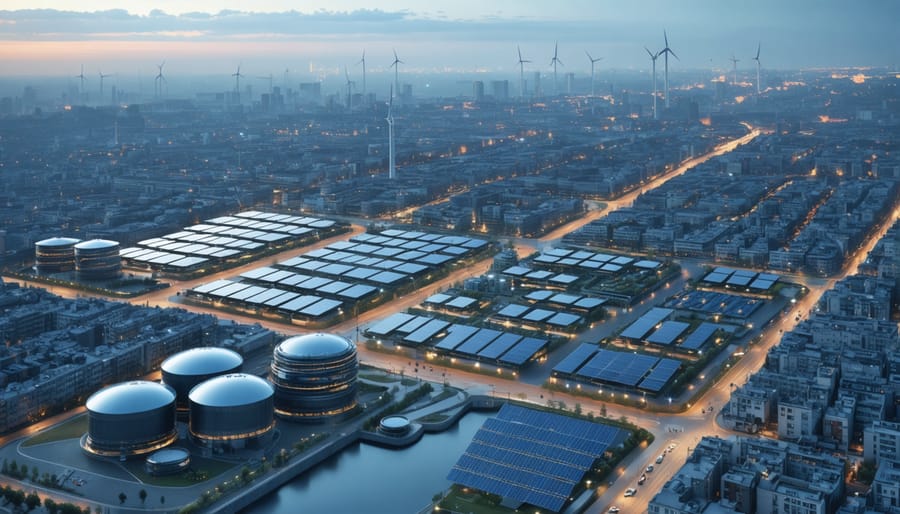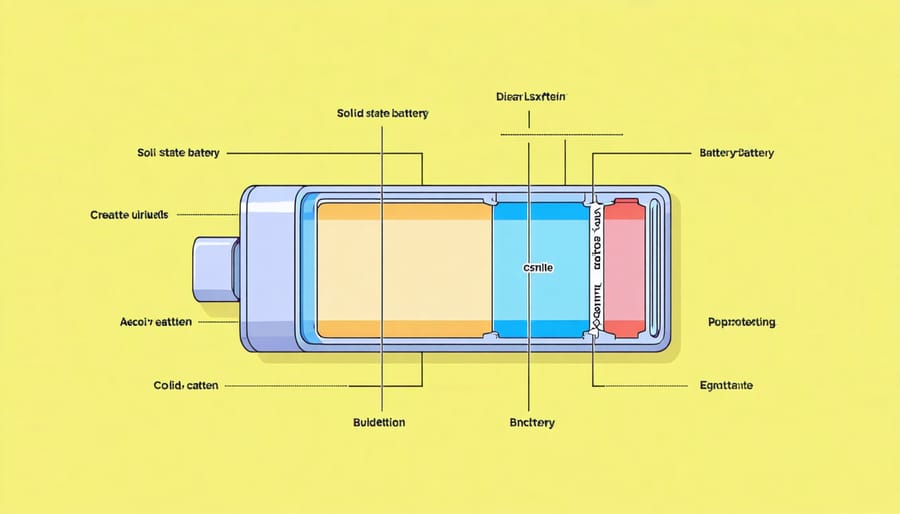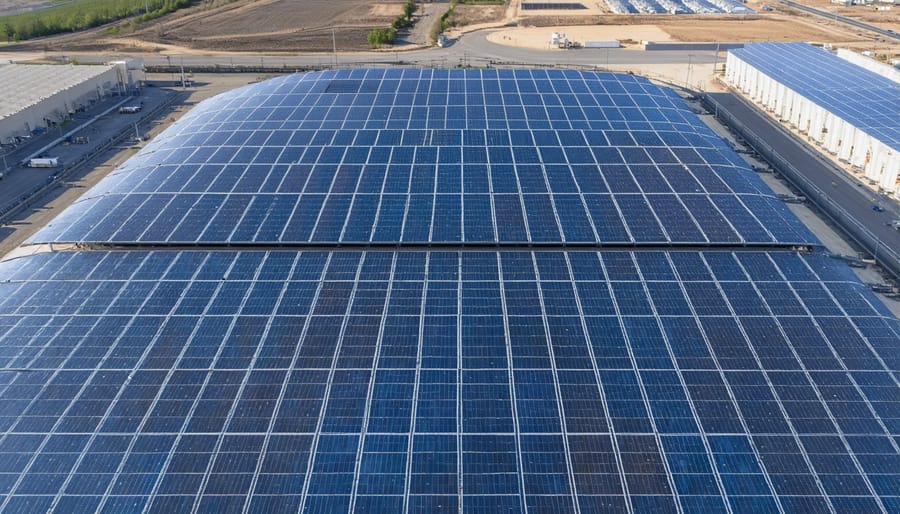Solar Storage Breakthroughs That Are Revolutionizing European Energy

Energy storage innovations are revolutionizing how we harness and utilize renewable power across Europe, marking a decisive shift in our approach to sustainable energy management. From advanced battery technologies to innovative thermal storage solutions, these breakthroughs are addressing the fundamental challenge of intermittent renewable energy generation, particularly in solar and wind power systems.
Recent developments in grid-scale storage technologies have achieved remarkable efficiency improvements, with new lithium-ion configurations reaching 95% round-trip efficiency and cost reductions of up to 40% compared to 2018 levels. These advancements are particularly significant for European markets, where the integration of renewable energy sources into existing power grids demands increasingly sophisticated storage solutions.
The emergence of hybrid storage systems, combining multiple technologies such as batteries, hydrogen fuel cells, and thermal storage, represents a particularly promising frontier. These integrated solutions offer unprecedented flexibility in managing energy flows, enabling businesses and households to optimize their energy consumption while contributing to grid stability.
As Europe accelerates its transition toward renewable energy, these storage innovations are becoming critical enablers of sustainable power systems, offering practical solutions for businesses and homeowners while supporting the continent’s ambitious climate goals.
Advanced Battery Technologies Reshaping Solar Storage
Solid-State Battery Innovations
In the realm of energy storage innovation, solid-state battery technology represents a significant breakthrough for solar energy systems. Unlike traditional lithium-ion batteries, solid-state batteries use solid electrolytes, eliminating the need for liquid components and substantially improving safety and stability.
These innovative batteries offer several compelling advantages for solar storage applications. They provide higher energy density, meaning more power can be stored in a smaller space – a crucial benefit for both residential and commercial installations. The solid electrolyte also enables faster charging capabilities and longer cycle life, potentially extending the battery’s serviceable lifespan by up to 50% compared to conventional alternatives.
European manufacturers are at the forefront of developing this technology, with several pilot projects demonstrating promising results. The batteries’ enhanced thermal stability makes them particularly suitable for various climate conditions across Europe, from Nordic winters to Mediterranean summers. They operate efficiently at a wider temperature range without requiring complex cooling systems.
Moreover, solid-state batteries align perfectly with Europe’s sustainability goals. They use fewer rare earth materials and present reduced environmental risks during production and disposal. While currently in the early stages of commercialization, industry experts project that mass production could begin within the next three to five years, potentially revolutionizing how we store solar energy.

Flow Battery Solutions
Flow battery technology represents a significant breakthrough in large-scale energy storage, particularly for solar applications. Unlike traditional batteries, flow batteries store energy in liquid electrolytes housed in separate tanks, allowing for independent scaling of power and energy capacity. This unique characteristic makes them particularly valuable for European solar installations requiring long-duration storage solutions.
The technology excels in applications where extended storage periods are necessary, such as industrial facilities and utility-scale solar farms. With operational lifespans exceeding 20 years and minimal capacity degradation, flow batteries offer a sustainable solution for the European energy market’s growing storage demands.
Recent innovations in flow battery chemistry have significantly improved their efficiency and cost-effectiveness. Vanadium-based systems currently dominate the market, offering reliable performance and recyclable materials. However, emerging organic electrolytes show promise in reducing costs while maintaining high performance standards.
Several European projects have successfully implemented flow battery systems alongside solar installations. For instance, a manufacturing facility in Germany utilizes a 2MW flow battery system to manage peak demand and store excess solar production, achieving substantial cost savings and enhanced grid stability.
The scalability of flow batteries makes them particularly attractive for community-scale projects and industrial applications. As installation costs continue to decrease and energy density improves, these systems are becoming increasingly viable for medium to large-scale energy storage requirements across Europe.
Thermal Energy Storage Systems
Molten Salt Storage Technology
Molten salt storage technology represents one of the most efficient solutions for large-scale thermal energy storage, particularly in solar power applications. This innovative system utilises specially formulated salt mixtures that can maintain temperatures between 290°C and 565°C, providing a reliable method for storing solar thermal energy during non-sunlight hours.
The process involves heating the salt mixture during peak sunlight hours, storing it in well-insulated tanks, and then using this thermal energy to generate steam for electricity production when needed. Modern molten salt systems can achieve remarkable efficiency rates of up to 99%, making them particularly attractive for utility-scale solar installations across Europe.
Several successful implementations already exist in Southern Europe, with Spain leading the way through projects like the Gemasolar power plant, which can generate electricity 24 hours a day thanks to its molten salt storage system. The technology’s reliability and proven track record have made it increasingly popular in regions with high solar potential.
Recent advancements in salt compositions and tank designs have further improved the technology’s cost-effectiveness and operational efficiency, making it a cornerstone of sustainable energy storage solutions. These systems can maintain power output for up to 15 hours, effectively bridging the gap between solar energy availability and demand patterns.

Phase Change Materials
Phase change materials (PCMs) represent a significant breakthrough in thermal energy storage, offering an innovative solution for maintaining stable temperatures in buildings and industrial processes. These materials work by absorbing or releasing heat during phase transitions, typically between solid and liquid states, while maintaining a nearly constant temperature.
In European applications, PCMs are increasingly integrated into building materials and HVAC systems. For instance, microencapsulated PCMs embedded in wall panels can absorb excess heat during warm daytime hours and release it when temperatures drop, effectively reducing heating and cooling demands by up to 30%.
The most common PCMs in commercial applications include paraffin waxes, salt hydrates, and fatty acids. Each type offers specific advantages: paraffins provide reliable performance and long lifecycle, salt hydrates offer high energy density, and fatty acids present an environmentally friendly alternative.
Recent innovations have improved PCM efficiency through enhanced heat transfer methods and advanced containment systems. European research centres have developed new composite materials that combine PCMs with graphene and metal foams, significantly improving thermal conductivity and energy storage capacity.
For industrial applications, PCM-based systems are particularly valuable in process heating and cooling, where they help maintain precise temperature control while reducing energy consumption.
Smart Integration Systems

AI-Powered Storage Management
Artificial intelligence is revolutionizing how we manage and optimize energy storage systems across Europe. Modern AI-powered storage management systems utilize advanced algorithms to predict energy demand patterns, weather conditions, and grid requirements, enabling more efficient energy distribution and storage.
These intelligent systems continuously analyze vast amounts of data from multiple sources, including weather forecasts, historical usage patterns, and real-time energy prices. By processing this information, AI can make split-second decisions about when to store excess energy and when to release it back to the grid, maximizing both efficiency and cost-effectiveness.
For homeowners and businesses, this translates into tangible benefits. AI algorithms can automatically adjust storage patterns based on individual consumption habits, enabling users to store energy when prices are low and utilize it during peak demand periods. This smart management approach typically results in 15-30% improved storage efficiency compared to traditional systems.
The integration of AI also enhances system longevity. By monitoring battery health and optimizing charging cycles, these systems can extend battery life by up to 20%. Furthermore, predictive maintenance capabilities allow for early detection of potential issues, reducing downtime and maintenance costs.
European utilities are increasingly adopting these intelligent solutions to balance grid loads more effectively, particularly in regions with high renewable energy penetration. This advancement marks a significant step toward a more sustainable and efficient energy future.
Grid Integration Solutions
Modern grid integration solutions are revolutionizing how stored solar energy interacts with existing power networks across Europe. Advanced inverter technologies now enable bidirectional power flow, allowing stored energy to seamlessly feed into the grid when demand peaks while maintaining stable voltage and frequency levels.
Smart grid management systems employ sophisticated algorithms to optimize energy distribution, predicting demand patterns and automatically adjusting storage discharge rates. These systems integrate weather forecasting data with consumption analytics to ensure reliable power supply, even during periods of variable solar generation.
Virtual Power Plant (VPP) platforms are emerging as crucial integration tools, particularly in countries like Germany and Denmark. These platforms aggregate multiple storage systems across different locations, creating a coordinated network that can respond to grid demands more effectively than individual units.
Grid-scale battery management systems now feature enhanced communication protocols that enable real-time interaction with grid operators. This advancement allows for precise control over power quality and helps prevent grid instability issues that were previously associated with renewable energy integration.
European utilities are increasingly implementing hybrid coupling solutions that combine multiple storage technologies. These systems typically pair batteries with other storage methods, creating more resilient and flexible grid integration capabilities while maximizing the utilization of stored solar energy.
For optimal grid integration, modern systems also incorporate power quality monitoring equipment and protective relaying, ensuring compliance with strict European grid codes while maintaining system reliability and safety.
European Implementation Success Stories
Commercial Applications
Several groundbreaking energy storage implementations across Europe demonstrate the practical impact of these innovations. In Germany, the BASF chemical plant in Ludwigshafen has successfully integrated a 900 MWh hybrid storage system combining lithium-ion batteries with hydrogen fuel cells, enabling the facility to operate with 40% renewable energy integration.
The Port of Rotterdam showcases another impressive commercial application, where a network of flow batteries provides 50 MWh of storage capacity, supporting port operations and enabling electric vessel charging. This system has reduced the port’s carbon emissions by an estimated 25% since its implementation in 2022.
In Sweden, the HYBRIT steel manufacturing project demonstrates industrial-scale energy storage innovation, using hydrogen storage systems to enable fossil-free steel production. The facility stores excess renewable energy in the form of hydrogen, which is later used in the steel-making process, marking a significant step toward decarbonizing heavy industry.
The retail sector has also embraced energy storage solutions, with Carrefour implementing a distributed storage network across 200 European locations. Each store features a 250 kWh battery system integrated with rooftop solar installations, reducing grid dependency by up to 60% during peak hours.
These commercial implementations highlight the versatility and scalability of modern energy storage solutions. From industrial applications to retail operations, businesses are increasingly recognizing the operational and environmental benefits of integrated storage systems, paving the way for wider adoption across various sectors.
Residential Success Stories
Across Europe, homeowners are embracing innovative residential energy storage solutions with remarkable success. In Munich, the Weber family installed a 10kWh battery system alongside their solar panels, achieving 85% energy self-sufficiency and reducing their annual electricity bills by €1,800. Their smart system automatically stores excess solar power during peak production hours and releases it during evening usage periods.
In Amsterdam, a community project involving 50 households implemented a networked storage system, allowing neighbours to share stored energy efficiently. This initiative reduced grid dependency by 60% and created a micro-grid that maintains power supply during regional outages. The project’s success has inspired similar implementations across the Netherlands.
A particularly innovative case emerged from Stockholm, where the Andersson household integrated their battery storage system with smart home automation. Their setup monitors weather forecasts and adjusts energy storage patterns accordingly, maximising solar utilisation even during Sweden’s varying seasonal conditions. The system achieved a remarkable 95% solar energy utilisation rate during summer months.
In Barcelona, the Martinez family’s installation combines a 7kWh battery with thermal storage, converting excess solar energy into hot water. This dual-purpose approach reduced their total energy consumption by 70% and virtually eliminated their gas bills. Their success story demonstrates how integrated storage solutions can address multiple household energy needs simultaneously.
These examples showcase how modern storage technologies are transforming domestic energy consumption patterns while delivering tangible financial and environmental benefits.
The rapid evolution of energy storage innovations represents a pivotal shift in how Europe approaches sustainable energy management. These technological breakthroughs are fundamentally reshaping our ability to harness and utilize renewable energy sources more effectively, particularly in solar applications. From advanced battery technologies to innovative thermal storage solutions, these developments are making renewable energy more reliable and accessible than ever before.
The impact of these innovations extends far beyond technical achievements. European businesses and homeowners are now experiencing tangible benefits through reduced energy costs, increased energy independence, and improved grid stability. The integration of smart energy management systems with state-of-the-art storage solutions is creating a more resilient and efficient energy infrastructure across the continent.
Looking ahead, the future of energy storage appears increasingly promising. Research and development in areas such as solid-state batteries, hydrogen storage, and advanced thermal solutions continue to push the boundaries of what’s possible. We can expect to see further improvements in storage capacity, efficiency, and cost-effectiveness, making these technologies even more accessible to European consumers and businesses.
As we move towards 2030 and beyond, these innovations will play a crucial role in achieving Europe’s ambitious climate goals and transitioning to a more sustainable energy future. The continued development of energy storage solutions, coupled with declining costs and increasing efficiency, will be instrumental in creating a more resilient and environmentally conscious energy landscape for generations to come.
Leave a Reply